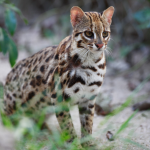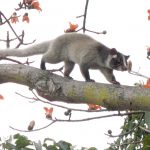Wildlife of Pakistan
On a mission, conservation of wildlife and landscapes
Small Indian Civet
 Local Names pf this species are Mushk Billa or Kasturi Billa. However, these are commonly known as Small Indian Civet or the Oriental Civets. Small Indian Civet is an alert and attractive cat-like animal with a pointed, cylindrical muzzle. The body is sandy buff in colour with black spots arranged in horizontal lines. Its claws are sharp, well-developed but non-retractable. It has a scent gland and therefore is locally referred to as Mushk Billa i.e. musk cat. Adults weigh about 3 kg and are about 45 -...
Local Names pf this species are Mushk Billa or Kasturi Billa. However, these are commonly known as Small Indian Civet or the Oriental Civets. Small Indian Civet is an alert and attractive cat-like animal with a pointed, cylindrical muzzle. The body is sandy buff in colour with black spots arranged in horizontal lines. Its claws are sharp, well-developed but non-retractable. It has a scent gland and therefore is locally referred to as Mushk Billa i.e. musk cat. Adults weigh about 3 kg and are about 45 -...
Common Palm Civet
 Like the other two species of civet cats, Paradoxurus hermaphroditus is also native to Pakistan. Commonly known as Common Palm Civet or Mentawai Palm Civet across its wide range, this species of Civet is often one of the most commonly recorded species of small carnivore. Across its range it has been found commonly in degraded and anthropogenic habitats, with some records from even the most degraded small isolates amid human environments.
Common Palm Civet uses a wide range of habitats including evergreen and deciduous forest (primary and secondary), seasonally flooded Melaleuca-dominated peat swamp forest,...
Like the other two species of civet cats, Paradoxurus hermaphroditus is also native to Pakistan. Commonly known as Common Palm Civet or Mentawai Palm Civet across its wide range, this species of Civet is often one of the most commonly recorded species of small carnivore. Across its range it has been found commonly in degraded and anthropogenic habitats, with some records from even the most degraded small isolates amid human environments.
Common Palm Civet uses a wide range of habitats including evergreen and deciduous forest (primary and secondary), seasonally flooded Melaleuca-dominated peat swamp forest,...
Balochistan Bear
A type of Asiatic bear and sub species of the Asian Black Bear, the Balo chistan bear is also referred to as the "moon bear" due to a crescent-shaped chest mark. These solitary bears live in forest habitats and can weigh over 300 pounds. Overall it is also smaller than the other subspecies and is more varietal and may be from reddish-orange to deep black. The Baluchistan bear is found only in the province of Baluchistan in southwest Pakistan and in southeastern Iran.
Unfortunately these are yet...
chistan bear is also referred to as the "moon bear" due to a crescent-shaped chest mark. These solitary bears live in forest habitats and can weigh over 300 pounds. Overall it is also smaller than the other subspecies and is more varietal and may be from reddish-orange to deep black. The Baluchistan bear is found only in the province of Baluchistan in southwest Pakistan and in southeastern Iran.
Unfortunately these are yet...
The Snow Leopard
 The snow leopard (Uncia uncia or Panthera uncia) is a somewhat huge cat indigenous to the hill differs of Southern region Japan and Middle Japan. The distinction of this types has been topic to modify and its actual taxonomic location will not be settled until further research are performed.
Snow leopards stay between 3,000 and 5,500 meters (9,800 and 18,000 ft) above sea level in the bumpy hill differs of Middle and Southern region Japan. Their discreet characteristics indicates that their actual statistics are mysterious, but it has been approximated that...
The snow leopard (Uncia uncia or Panthera uncia) is a somewhat huge cat indigenous to the hill differs of Southern region Japan and Middle Japan. The distinction of this types has been topic to modify and its actual taxonomic location will not be settled until further research are performed.
Snow leopards stay between 3,000 and 5,500 meters (9,800 and 18,000 ft) above sea level in the bumpy hill differs of Middle and Southern region Japan. Their discreet characteristics indicates that their actual statistics are mysterious, but it has been approximated that...
Wild Stoats
 The stoat (Mustela erminea), also known as the ermine or short-tailed weasel, is a types of Mustelid indigenous to Eurasia and Northern The united states, recognized from the least weasel by its bigger dimension and more time trail with a popular dark-colored tip. Its variety has enhanced since the overdue 1800s to involve New Zealand, where it is attributed for decreases in ancient chicken communities. It is considered by the IUCN as Least Issue, due to its large circumpolar submission, and the truth that it does not experience any...
The stoat (Mustela erminea), also known as the ermine or short-tailed weasel, is a types of Mustelid indigenous to Eurasia and Northern The united states, recognized from the least weasel by its bigger dimension and more time trail with a popular dark-colored tip. Its variety has enhanced since the overdue 1800s to involve New Zealand, where it is attributed for decreases in ancient chicken communities. It is considered by the IUCN as Least Issue, due to its large circumpolar submission, and the truth that it does not experience any...
Woolly Flying Squirrel
 Woolly flying squirrel, an introverted sociable animal, is endangered with extinction, as it faces many threats. The fast deprivation of its habitat and exposure to human being are the main causes that put its life in jeopardy.
Found in Northern regions (Gilgit-Baltistan) merely and nowhere else, it is one of the least studied species on the planet. There are 3 species of airborne squirrels in Pakistan which are found in temperate zone in the northern hills, as well as Murree Hills.
The giant Red Flying...
Woolly flying squirrel, an introverted sociable animal, is endangered with extinction, as it faces many threats. The fast deprivation of its habitat and exposure to human being are the main causes that put its life in jeopardy.
Found in Northern regions (Gilgit-Baltistan) merely and nowhere else, it is one of the least studied species on the planet. There are 3 species of airborne squirrels in Pakistan which are found in temperate zone in the northern hills, as well as Murree Hills.
The giant Red Flying...
Leopard Cat
 This species is evaluated as Least Concerned on the red list of threatened species (IUCN) as it is broadly distributed around the world but it is vulnerable to habitat loss and hunting in Pakistan. Thus they are hard to spot in the...
This species is evaluated as Least Concerned on the red list of threatened species (IUCN) as it is broadly distributed around the world but it is vulnerable to habitat loss and hunting in Pakistan. Thus they are hard to spot in the...
Masked Palm Civet
 Other common names of the species are Himalayan Palm Civet and Gem-faced Civet. The Asian palm civet is common, but conservationists claim that related species are sometimes used in coffee business which is under threat of extinction. There is a high mortality rate and for some species of civet, there’s a real conservation risk. People need to be aware that tens of thousands of civets are being kept in these conditions.
Major Threats: Masked Palm Civet is threatened, potentially, by habitat reduction and by overharvest....
Other common names of the species are Himalayan Palm Civet and Gem-faced Civet. The Asian palm civet is common, but conservationists claim that related species are sometimes used in coffee business which is under threat of extinction. There is a high mortality rate and for some species of civet, there’s a real conservation risk. People need to be aware that tens of thousands of civets are being kept in these conditions.
Major Threats: Masked Palm Civet is threatened, potentially, by habitat reduction and by overharvest....